Astronomy Photographer of the Year 2017 winners revealed – and they're out of this world
Spectacular space images from the winners of the Insight Astronomy Photographer of the Year 2017 competition.
Russian photographer Artem Mironov has beaten thousands of amateur and professional photographers from around the globe to win the title of Insight Astronomy Photographer of the Year 2017, run by the Royal Observatory Greenwich in association with Insight Investment and BBC Sky at Night Magazine.
Stars and Nebulae Winner and Overall Winner: Artem Mironov (Russia) The Rho Ophiuchi Clouds
Taken over three nights at a farm in Namibia near Gamsberg Mountain, this image depicts the Rho Ophiuchi Cloud Complex, sometimes known as 'Rho Oph' for short or the Ophiuchus Molecular Cloud, named after a bright star in the region. It is a dark emission and reflection nebula about 14 light years across and is situated approximately 460 light years away from our planet, in the constellation of Ophiuchus (the 'Serpent-Bearer'). It is one of the closest star-forming regions to the Solar System. Sky-Watcher 200 mm f/4 reflector telescope, Sky-Watcher HEQ5 Pro mount, Canon 5D Mark II camera, ISO 1600, 15-hour total exposure

The judges were enthralled by Mironov's sumptuous image depicting the vibrant blues and pinks of the swirling dust and gas clouds in the Rho Ophiuchi Cloud Complex. Mironov captured the sprawling stellar nursery that recent x-ray and infrared studies have revealed to be a home to a cluster of more than 300 protostars. Competition judge and Royal Observatory Public Astronomer, Dr Marek Kukula said: "There's an astonishing richness of colour and structure in this gorgeous image. It's a popular part of the sky for astrophotographers but this image shows it to us in a fresh light and there's a sense of mystery in the churning clouds of gas and dust which reminds us that there's still so much to discover out there. A dazzling corner of our galaxy captured perfectly".
As well as securing the £10,000 top prize, Mironov's image takes pride of place in the exhibition of winning photographs opening at the Royal Observatory Greenwich on 16 September 2017. IBTimes UK presents the winners, runners-up and highly commended images in each category:
Stars and Nebulae Runner Up: Andras Papp (Hungary) One Stellar Day
Although we measure a day as 24 hours, it actually only takes 23 hours, 56 minutes and 4 seconds for our planet spinning on its axis to complete one rotation. This true rotational period of the Earth is known as the 'sidereal day' or 'stellar day'. Here, the photographer has captured the motion of the stars over the course of one 'stellar day' illustrated by beautiful concentric star trails. Ágasvár, Veszprémvarsány, Hungary, 2 November 2016. Canon EOS 700D camera, 18–135 mm at 135 mm f/7.1, Sky-Watcher HEQ5 mount with home-made camera holder, ISO 800, 287 x 300-second exposures.
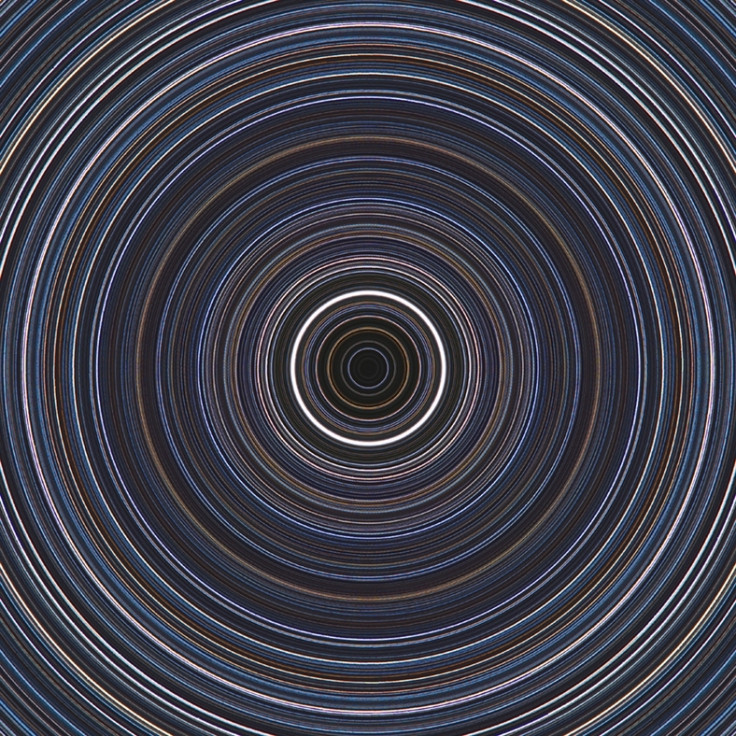
Stars and Nebulae Highly Commended: Andriy Borovkov (Ukraine) NGC 281 Pacman
The NGC 281 nebula, shown here, is sometimes referred to as the 'Pacman Nebula' due to its striking resemblance to the much-loved video game character. In the ordinary colours of the visible light spectrum it can look rather dreary, so to combat this, the photographer used the Hubble Palette (HST), showcasing the nebula with a vibrant blue surrounded by rusty oranges. The image was taken during August and September 2016 in the small town of Elmshorn, Germany. The original stars in this picture were then replaced with RGB (red, green and blue) coloured stars. UNC 30512 305 mm f/4 reflector telescope, Sky-Watcher EQ8 mount, Moravian Instruments G2-8300 Mono CCD camera, 25-hour total exposure.
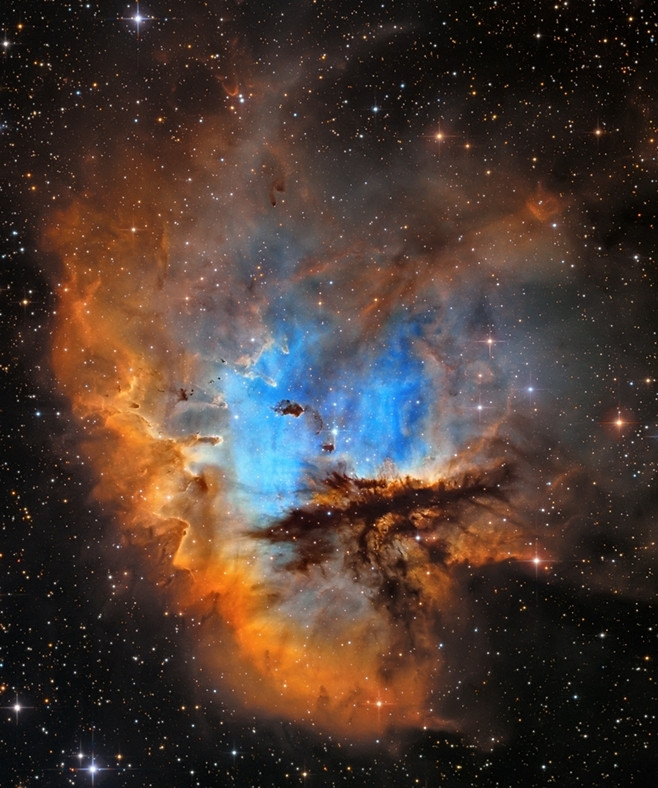
People and Space Winner: Yuri Zvezdny (Russia) Wanderer in Patagonia
A lone stargazer stares up at the stars of our galaxy, the Milky Way, as they stretch across the night sky over the glacier 'White Stones' (Piedras Blancas) in the Los Glaciares National Park, Argentina. Alone in the darkness, the photographer made his way over the huge rocks with the mountain river roaring under his feet and the glacier rumbling nearby. iOptron Sky-Tracker mount, Sony A7S camera, 18 mm f/2.8 lens, ISO 5000, 30-second exposure
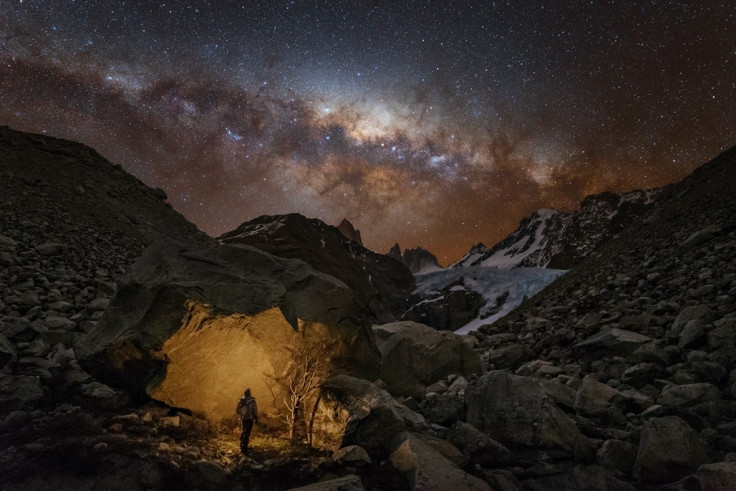
People and Space Runner Up: Kurt Lawson (USA) The Cable Route of Half Dome at Night
The photographer along with fellow astrophotographer Sean Goebel embarked on a mission to shoot a night hike up the Cable Route of Yosemite's Half Dome. Hiking some 110lbs (50 kg) of gear and water between them to the summit of Mount Watkins, a sculpted rocky summit northeast of Half Dome on the other side of Tenaya Canyon, they set up their cameras for time-lapse and stills while another friend, Wade Meade, made the ascent from Yosemite Valley to the summit, lighting the trail with a small lantern and some bright headlamps. Nearly clear skies allowed for the capture of the movement of the stars above this incredible landscape and shooting it at night allowed them to capture the path up Yosemite's famous granite icon. 8 x 8 minute exposures were stacked in Photoshop for a total exposure of 64 minutes right as the Milky Way passed over the summit. Sony α7R camera, 100 mm f/2.8 lens, ISO 500, 64-minute exposure
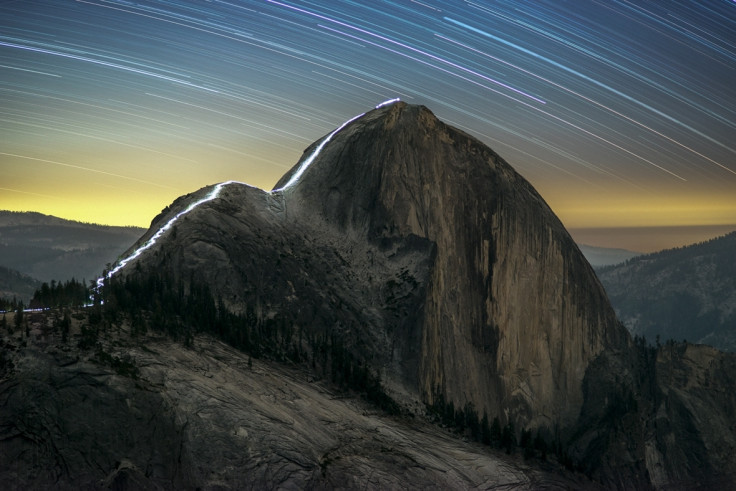
People and Space Highly Commended: Fu Dingyan (China) Interstellar Travel
In an attempt to recreate feeling of travelling in space, the photographer escaped the lights of the city and ventured to Réunion Island, located off the coast of Madagascar. Dressed in a spacesuit, standing under the southern Milky Way and the Large and Small Magellanic Clouds, the photographer resembles an interstellar traveller. Nikon D4S camera, 14-24 mm lens at 14 mm f/2.8, ISO 500, 30-second exposure.
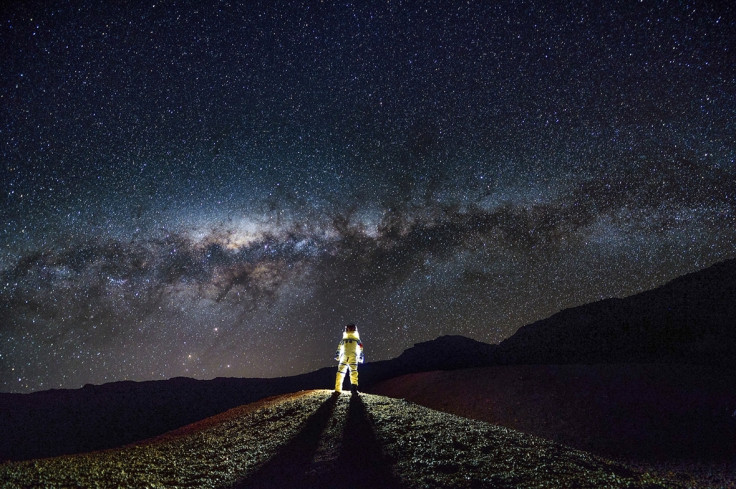
Aurorae Winner: Mikkel Beiter (Denmark) Ghost World
During October 2016 the photographer stood and observed the waves from the sea slowly rolling up on the long beach making the sand wet, resulting in great conditions for catching some reflections. Suddenly, clouds emerged from the nearby mountains and floated across the sea allowing him to capture this other-worldly scene of a powerful, teal aurora sweeping across the night sky in Stokksnes, Iceland. Canon EOS 5D Mark III camera, 24 mm f/2.0 lens, ISO 1600, 6-second exposure.

Aurorae Runner Up: Kamil Nureev (Russia) In Autumn Dance
A glowing green auroral ray arcs through the night sky over the Siberian forest-tundra. The photo consists of eight vertical scenes shot on a lens with a fixed focal length of 24 mm. Over the course of shooting, every second was precious as the polar light was very dynamic and the photographer had to move as quickly as possible to authentically capture the scene. The polar shine silhouette reminds the photographer of the mathematical 'golden ratio'. Canon 5D Mark III camera, 24 mm f/2.0 lens, ISO 2000, 4-second exposure.

Aurorae Highly Commended: Ziyi Ye (China) Aurora Shot from Plane
The vivid green aurora swirls over the deep, blue sky and the orange glow of twilight as seen from the window of a plane travelling from Amsterdam to Beijing. The photographer had been expecting an auroral outburst to occur during the flight, so paid for the seat that was best for observing. As well as the strong auroral activity, the photographer was also blessed with a white night (a period around the summer solstice when the sun hardly sets) making twilight visible on the horizon. The crew aided in capturing the scene from this unusual perspective by providing the photographer with some blankets to cover the entire window and block out light from the cabin. Novosbirsk, Russia, 24 August 2016. Canon EOS 6D camera, 20 mm f/1.8 lens, ISO 2000, 3-second exposure.
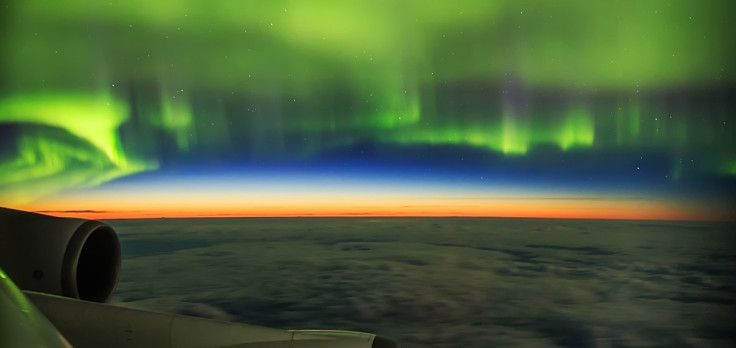
Our Moon Winner: László Francsics (Hungary) Blue Moon
This hyper-saturated picture depicts the face of the lunar surface in a new light. On the brownish terra of our natural satellite, the Moon, the impact crater and its ray system appear as blue-white structures that extend over a thousand miles. The Tycho Crater, named after Danish astronomer Tycho Brahe, has a bluish shade that is characteristic of the youngest craters on the Moon, with this particular feature estimated to be 108 million years old. 250 mm f/4 reflector telescope at f/10, Sky-Watcher EQ6 mount, ZWO ASI290MM and Sony SLT A99V cameras, composite of 5000 monochrome frames and 50 colour frames.
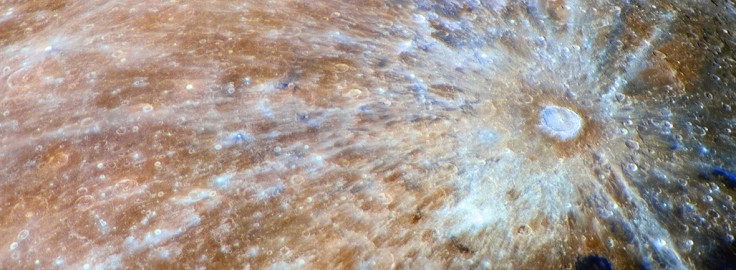
Our Moon Runner Up: Jordi Delpeix Borrell (Spain) Evening in the Ptolemaeus Chain and Rupes Recta Region
A close up of the craggy face of the Moon, shows the south central lunar face is dominated by the magnificent chain of walled plains: Ptolemaeus, Alphonsus and Arzachel. Walled plains are large impact craters whose floors have been filled with lava, eliminating many traces of the original floor and central elevation. In the bottom part of this composite image (made up of two individual pictures) is Ptolemaeus, an ancient crater with no central peak but with multiple smaller craters across its floor surface. Above Ptolemaeus is Alphonsus, which also contains several craterlets on its floor. Alphonsus also has a central peak and contains Rimae Alphonsus, a network of narrow rilles, or ancient lava channels, on the left side of its floor. Above Alphonsus, Arzachel makes a superb addition to the Ptolemaeus chain, with terraced walls, a large central elevation, and a floor containing a cleft and several large craterlets. Above and to the right of Arzachel is Rupes Recta (meaning 'Straight Wall', a large linear fault) and to its right are the crater Birt and the Rima Birt rille. L' Ametlla del Vallès, Barcelona, Spain, 25 August 2016. Celestron C14 355.6 mm f/11 Scmidt-Cassegrain telescope at f/19, Sky-Watcher NEQ6 Pro mount, ZWO ASI 174MM camera, 500 of 6600 frames stacked.
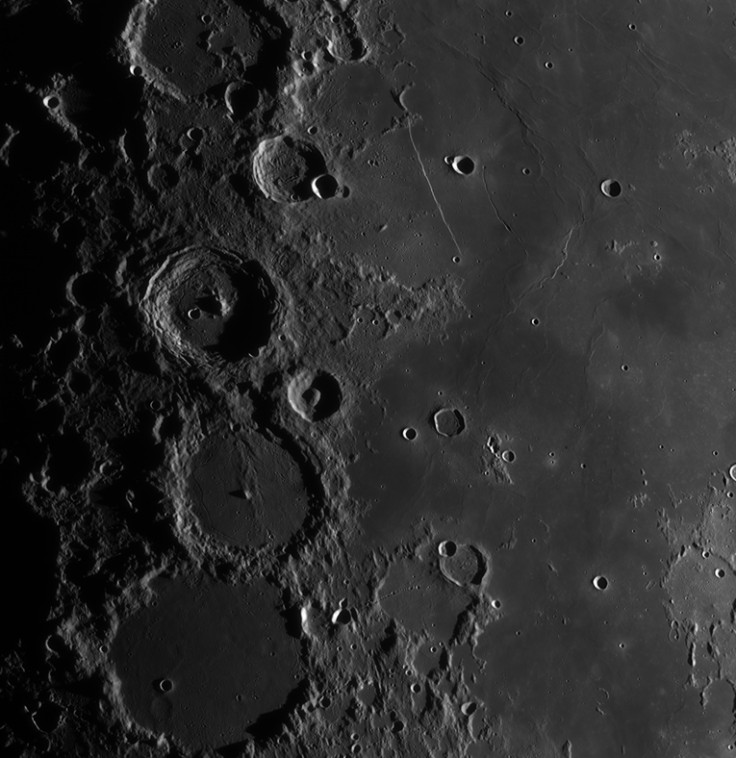
Our Moon Highly Commended: Sean Goebel (USA) Mauna Kea Moonset
A giant Moon looms behind the telescopes atop the snow-capped dormant volcano, Mauna Kea. Despite being in Hawaii, Mauna Kea is tall enough (4,200m) to accumulate snow during the winter. The telescopes are, from left to right, the UK Infrared Telescope, the University of Hawaii 2.2m telescope, Gemini North, and Canada France Hawaii Telescope. After several months of waiting for clear skies (it's nearly always cloudy in Hilo, where this was taken from), the photographer had an opportunity to capture the Full Moon setting at sunrise, and this shot is a still frame from a timelapse video. Canon EOS 7D Mark II, 1000 mm f/11 lens, ISO 320, 1/500-second exposure.
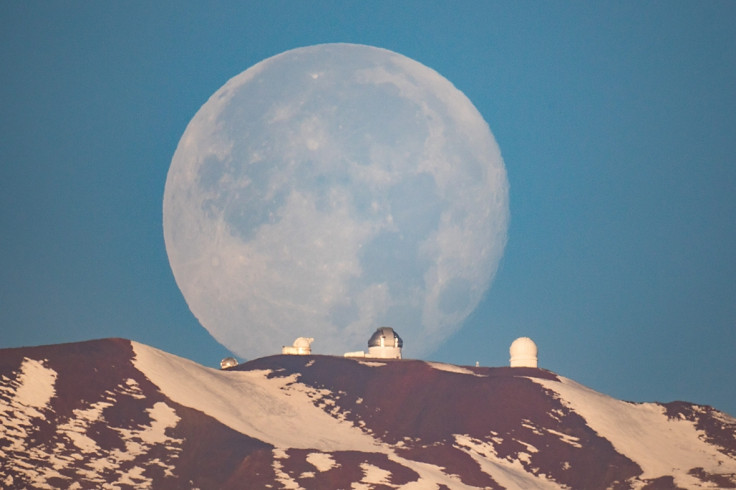
Our Sun Winner: Alexandra Hart (UK) Mercury Rising
On 9 May 2016, the Transit of Mercury occurred, with the smallest planet in the solar system passing directly between the Earth and the Sun over the course 7.5 hours – the longest transit of the century. Mercury can be seen towards the centre of our star in the image as a tiny black dot. The day of the transit had dawned cloudy but weather forecasts showed clear skies to the north, and the photographer was lucky enough to have a very kind friend who offered the use of his garden so that they were able to view the transit from beginning to just past mid-point. Preston, Lancashire, UK, 9 May 2016. TEC140 140 mm f/7 refractor telescope at f/9.8, Solarscope DSF100 H-alpha filter, Sky-Watcher EQ6 Pro mount, PGR Grasshopper 3 camera, stacked from multiple exposures.
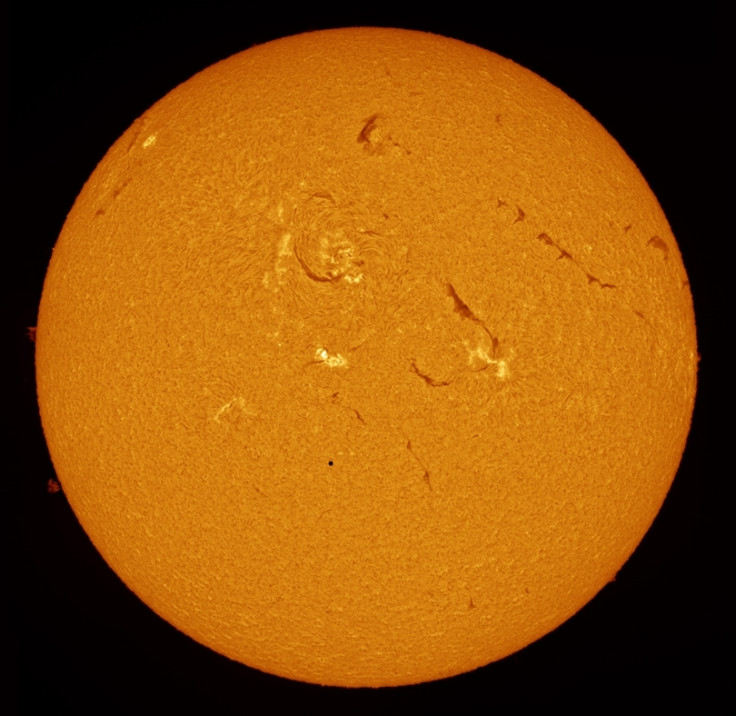
Our Sun Runner Up: Eric Toops (USA) Solar Limb Prominence and Sunspot
A striking image of a searing solar limb prominence and Sunspot on the surface of our star, taken during the spring of 2016. The best time of the year for imaging the Sun accompanied by a cool breeze and good viewing conditions made for a pleasant time for the photographer. Using Lunt H-alpha filters in a custom-made telescope the photographer was able to bring out incredible details of the solar activity using high magnification. Several photos were stacked to stabilise the image and the blurriness of the Earth's atmosphere. Hoschton, Georgia, USA, 19 April 2016. Home-made telescope, Point Grey GS3-U3-60S6M camera.

Our Sun Highly Commended: Michael Wilkinson (UK) Ghostly Sun
The Sun photographed in Calcium-K light, depicting the star's inner chromosphere. In the colour-rendering scheme used, the surface is shown as negative, with the sunspots as bright spots, but the area outside the limb is shown with increased contrast, highlighting a surge on the western limb, and several small prominences. Although the Sun is shown entering a quieter phase, a lot of activity is still taking place, illustrating just how dynamic our star is. Groningen, Netherlands, 4 April 2017. APM 80 mm f/6 refractor telescope, Vixen Great Polaris mount, ZWO ASI178MM camera, stack of 400 frames.
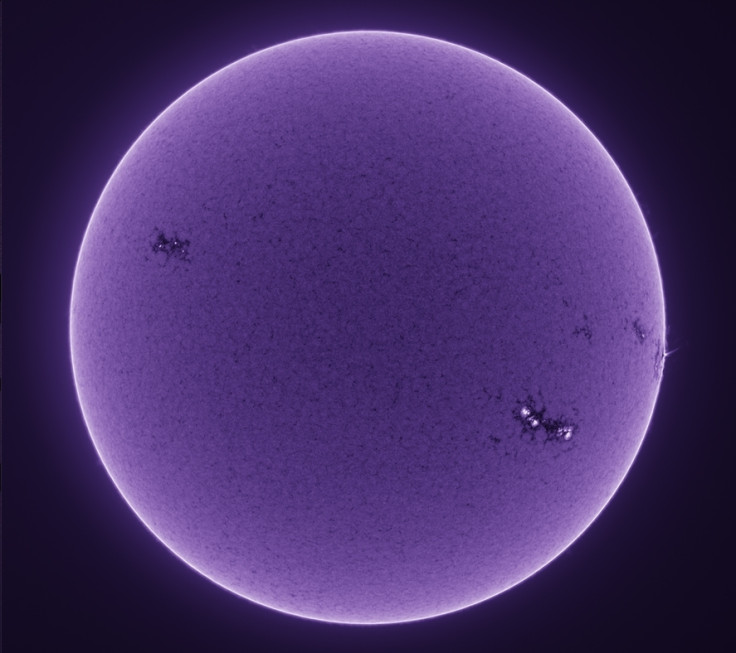
Skyscapes Winner: Haitong Yu (China) Passage to the Milky Way
The serene sight of the dusky, Milky Way viewed through the minimalist outdoor passageway of LAMOST (the Large Sky Area Multi-Object Fibre Spectroscopic Telescope) at the National Astronomical Observatory of China. Shot with an 85 mm lens, the image is a composite of a three-panel panorama, each one with a single exposure. Xinglong, Hebei Province, China, 9 April 2016. Sony ILCE-7s camera, 85 mm f/1.4 lens, ISO 10000, panorama of three 8-second exposures.
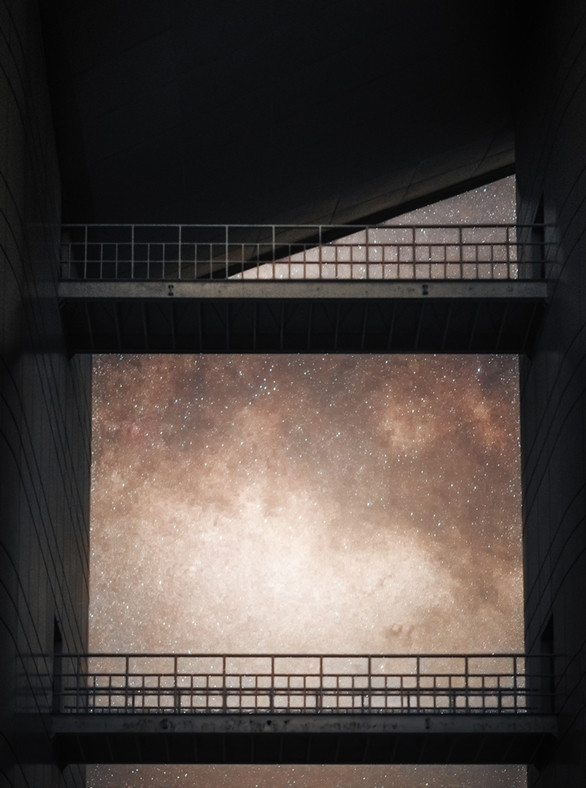
Skyscapes Runner Up: Zhong Wu (China) Star Track in Kawakarpo
The stars beam down on to the Meili Snow Mountains, also known as the Prince Snow Mountains, the highest peaks in Yunnan Province, China. It is world-renowned for its beauty and is one of the most sacred mountains in Tibetan Buddhism. The moonlight striking the top of the mountains appears to give them an ethereal quality. Nikon D810 camera, 35 mm f/5.6 lens, ISO 200, 900-second exposure.
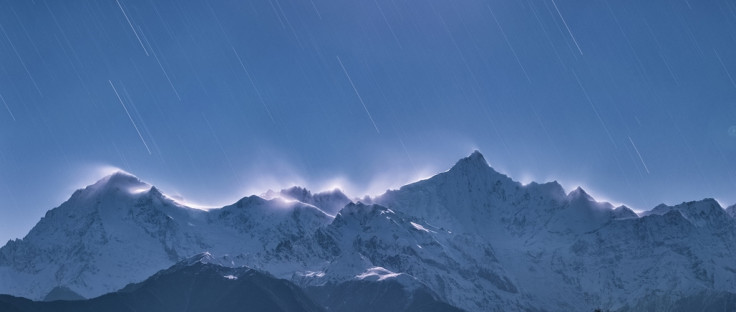
Skyscapes Highly Commended: Bartlomiej Jurecki (Poland) Nacreous Clouds
A spectrum of colour rolls across the sky over Lofoten, Norway in the form of nacreous clouds, also known as mother-of-pearl clouds due to their almost shimmering appearance. Formed over the Polar Regions in the stratosphere, when the Sun is just below the horizon at sunset it illuminates clouds from below. The particles that make up nacreous clouds are much smaller than those in more common clouds meaning that the light from the Sun is scattered and diffracted quite dramatically as it passes through them, resulting in a strikingly colourful display. Nikon D800 camera, 300 mm f/7.1 lens, ISO 10, 1/800-second exposure.
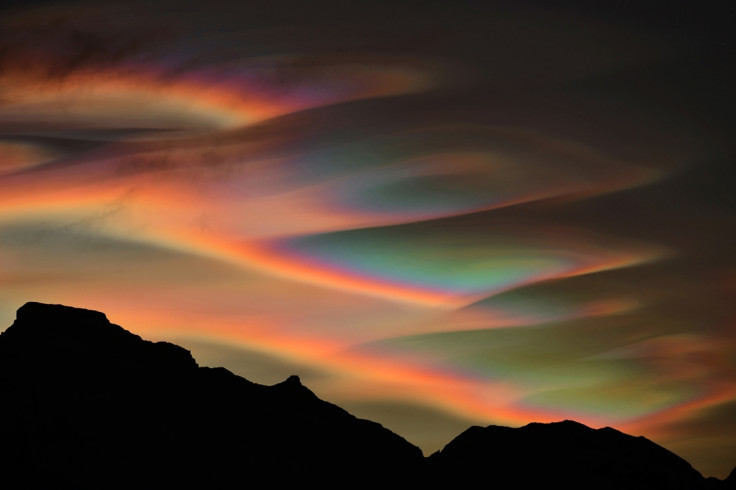
Galaxies Winner: Oleg Bryzgalov (Ukraine) M63: Star Streams and the Sunflower Galaxy
A bright, spiral galaxy, Messier 63 looks like a star necklace in which the stars have crashed outwards from the galaxy's centre, producing this fantastic long train. The ghostly star arcs of the Sunflower galaxy had long been an elusive target for the photographer, but upon deciding to take the image in one of the darkest places in Europe – the Rozhen Observatory in the Rhodopes Mountains, Bulgaria – he successfully captured the astronomical object. Despite a warm winter and an early spring, there were snow drifts more than one metre high and it took a lot of effort to break through them, but the photographer prevailed, and captured the glittering galaxy in the unbelievably dark and crystal clear of Rhozen. 10-inch f/3.8 homemade reflector telescope at f/4.4, Whiteswan 180 mount, QSI 583wsg camera, 22-hour total exposure.
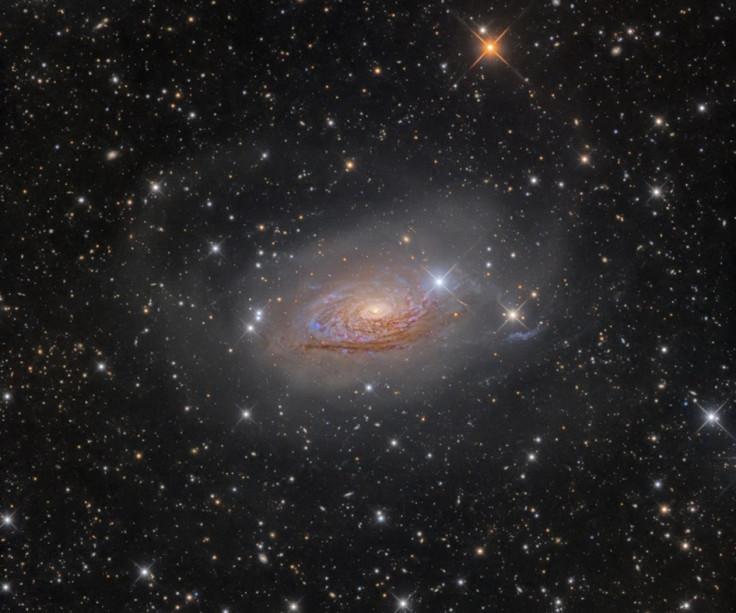
Galaxies Runner Up: Bernard Miller (USA) NGC 7731 – The Deer Lick Group
NGC 7331 is an unbarred spiral galaxy found some 40 million light years away from Earth, in the constellation Pegasus. Of the group of galaxies known as the Deer Lick Group, NGC 7331 is the largest, and can be seen dominating the image whilst the smaller galaxies NGC 7335, NGC 7336, NGC 7337, NGC 7338 and NGC 7340 drift above it. Animas, New Mexico, USA, 30 October 2016. PlaneWave CDK-17 17-inch reflector telescope at f/6.8, Paramount ME mount, Apogee CG16M camera, 18-hour total exposure.
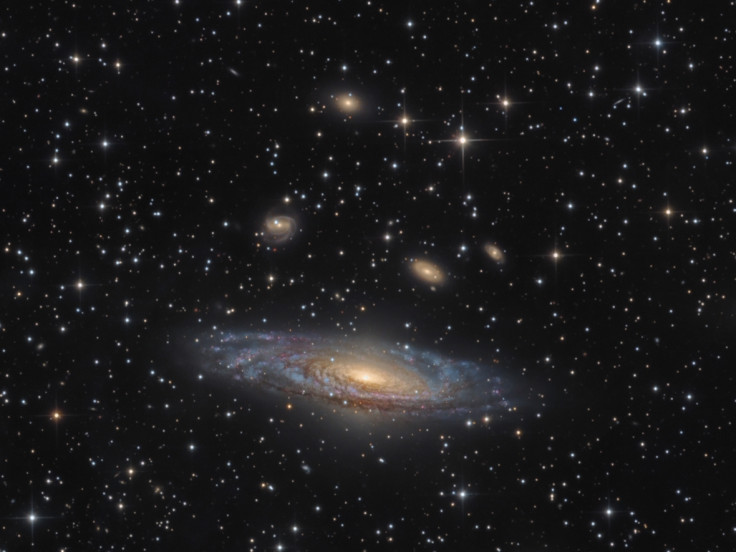
Galaxies Highly Commended: Andriy Borovkov (Ukraine) NGC 4565 – Needle Galaxy
NGC 4565 has come to be known as the Needle Galaxy due to its narrow profile. Lying in the constellation of Coma Berenices, approximately 40 million light years away, the Needle Galaxy is more luminous than our neighbouring galaxy, the Andromeda Galaxy. For many astrophotographers, galaxies are rather tricky to shoot in city conditions. While the centre region can be shot without many obstacles, it takes a huge amount of work to show the side arms and periphery properly. Luckily there are some galaxies, such as the Needle Galaxy, that are oriented quite neatly for photographers. The photographer began collecting the data for this image in February 2016 and managed to get an hour of clear sky but unfortunately the major part of it was taken in March in rather unlucky conditions. But as we look at this galaxy from the side on Earth, the spiral arms are in a ray and, even with the cloudy night sky, the photographer still captured an image to be proud of. Elmshorn, Pinneberg, Schleswig-Holstein, Germany, 14 March 2016. UNC 30512 300 mm f/4 reflector telescope, Sky-Watcher EQ8 mount, Moravian Instruments G2-8300 mono camera, 9.-hour total exposure.
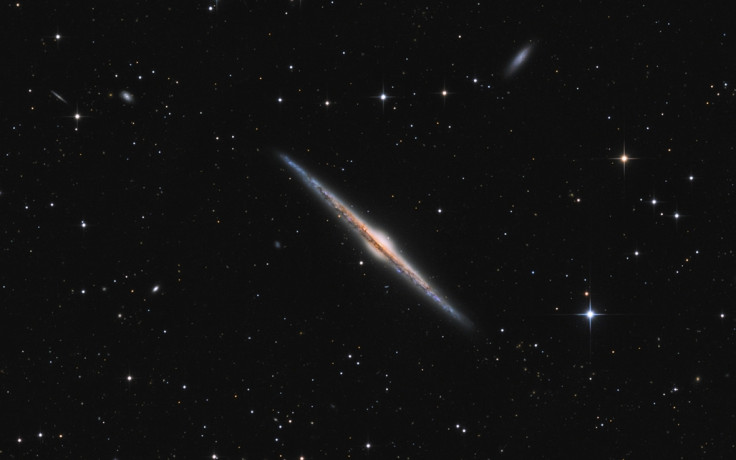
Planets, Comets and Asteroids Winner: Roger Hutchinson (UK) Venus Phase Evolution
The changing face of our neighbouring planet Venus as it grew from 86.6% illuminated and 11.9 inches in diameter on the 25th September 2016, to 1% illuminated and 59.3 inches in diameter six months later, as seen from London. All the images were taken with the same setup, so the changing size of Venus, as it approached the point between us and the Sun, is really apparent. Infrared and Ultraviolet filters were used to capture cloud features during the larger crescent phases, and those where the apparent diameter is small or the crescent is thin, were taken using only an Infrared pass filter. All were stacked in Autostakkert and sharpened in Registax. Final processing was performed in Photoshop CC. Celestron C11 EdgeHD 355.6 mm f/10 reflector telescope, Celestron CGE Pro mount, ZWO ASI174MM camera, composite of panels stacked from multiple exposures.
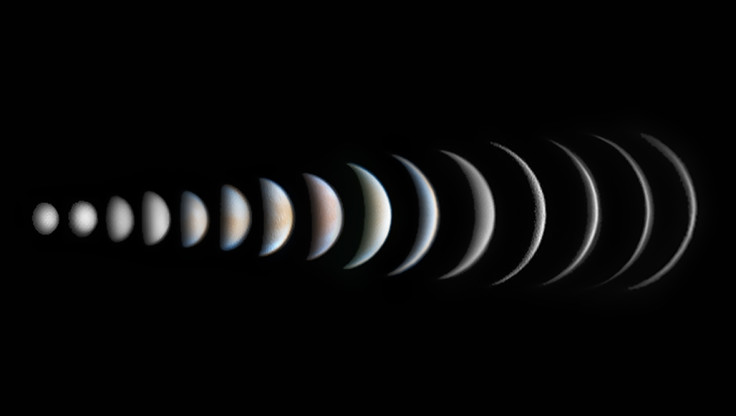
Planets, Comets and Asteroids Runner Up: Tunç Tezel (Turkey) Retrograde Mars and Saturn
The paths of the planets Mars and Saturn shown swooping through the night sky, over a period of 11 months in 2016. Last year was a special year for monitoring the two planets because they spent the year close to each other, north of Antares in Scorpius. Mars was in opposition on 21–22 May, while Saturn's own opposition came just 12 days later, on 2–3 June. They even traced their respective retrograde loops simultaneously next to each other. The planets were photographed on 46 different dates over 11 months, roughly once per week. For the master image, the photographer used an image from the morning of 9 March 2016 from eastern Halmahera, Indonesia, due to the excellent conditions and lack of light pollution or haze. I registered the rest of the shots on to this master, which were mostly from Bursa, Turkey. The exposures of other nights ranged from 6 to 30 seconds according to the changing conditions of the sky, the effects of moonlight and light pollution. Canon EOS 6D camera, 50 mm f/3.5 lens, ISO 3200, composite of multiple exposures.
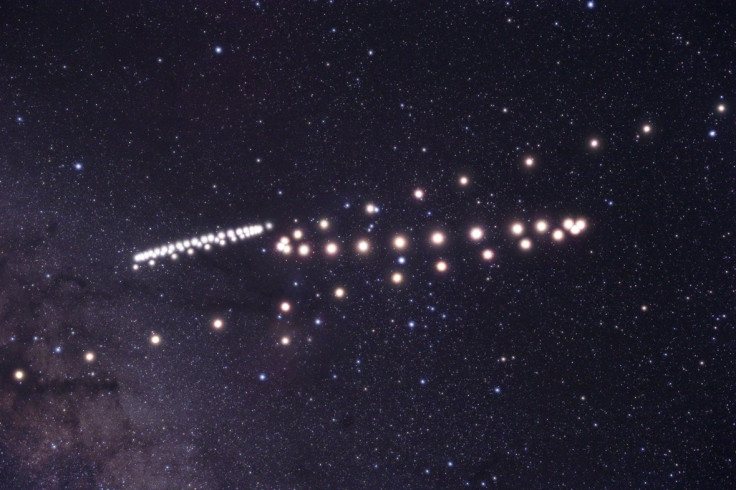
Planets, Comets and Asteroids Highly Commended: Derek Robson (UK) Near Earth Object 164121 (2003 YT1)
On 31 October 2016, Near Earth Asteroid 164121 (2003 YT1) made a close encounter with Earth at three million miles. This Apollo asteroid with an orbital period of 427 days was discovered by the Catalina Sky Survey on 18 December 2003. The photographer's first attempt at imaging the asteroid was done with a camera on a fixed tripod, controlled by Astrophotography Tool software. The asteroid moved so fast he could see it moving on the live screen. The negative image is a stack of 56 cropped images created using PIPP and Deep Sky Stacker software and was processed with IrfanView and Photoshop for scientific content rather than cosmetic appearance. Loughborough, Leicestershire, UK, 2 November 2016. Canon 1100D, 300 mm f/5.6 lens, ISO 1600, 56 x 25-second exposures.
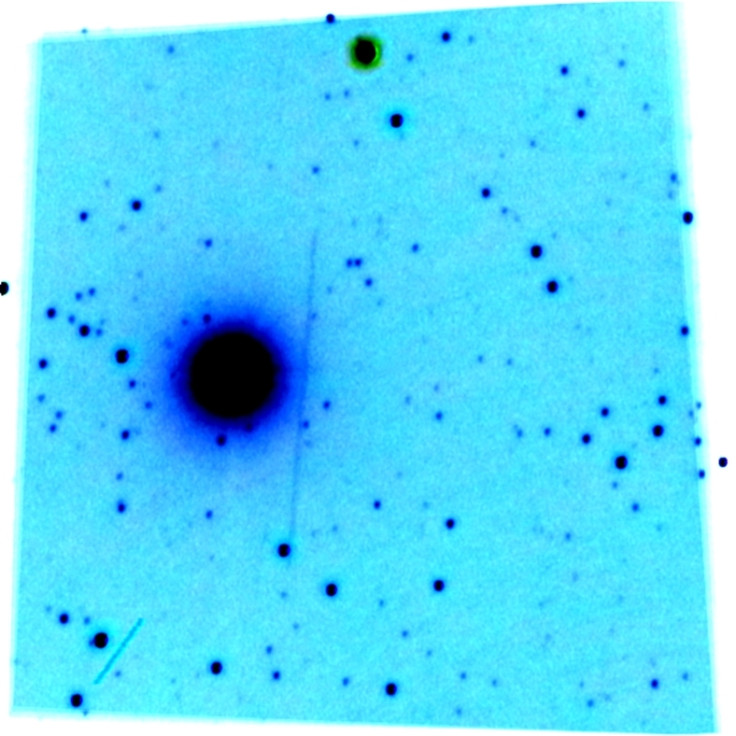
The Sir Patrick Moore prize for Best Newcomer: Jason Green (Gibraltar) The Cone Nebula (NGC 2264)
A vivid deep-red image of the Cone Nebula, lying about 2,700 light years away in the constellation of Monoceros. The image consists of 20 x 10-minute exposures per filter and is an integration of LRGB (luminance, red, green and blue) and H-Alpha (hydrogen-alpha) filters. The image is calibrated with flat frames and bias frames, aligned and combined to produce one integrated full colour image. PixInsight and Photoshop was used to process the image. Frenegal de la Sierra, Badajoz, Spain, 10 January 2017. William Optics 132 mm f/5.6 apochromatic refractor telescope, Celestron CGE Pro mount, QSI 660WSG8 Mono CCD camera, 16 <sup>2/3-hour total exposure.

Robotic Scope: Gerald Rhemann (Austria) Encounter of Comet and Planetary Nebula
A vibrant image showing the glowing green, comet C/2013 X1 PanSTARRS whizzing past the luminous pink and blue Helix Planetary Nebula, on 5 June 2016. This photograph was taken at an observatory on Tivoli Farm in Namibia, where the photographer installed a mount and telescope with a friend of his. The observatory is fully remote-controlled and frequently maintained during visits, and enabled the photographer to capture this mosaic image of two panels. ASA Astrograph 12-inch N 300 mm f/3.6 reflector telescope, ASA DDM 85 mount, FLI Microline ML 16200 camera, 94-minute total exposure.
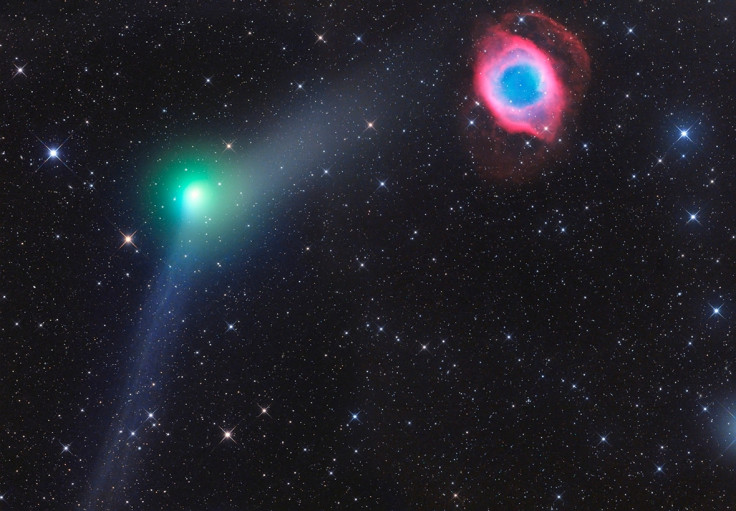
Young Astronomy Photographer of the Year Winner: Olivia Williamson (UK – aged 13) Saturn
An incredibly detailed image of the ringed planet, Saturn, which the photographer captured on a trip to the desert near Al Khanzna, with her dad. The conditions on 27 May meant the body of Saturn appeared to have more detail than the photographer had ever seen before, resulting in a trip to the desert to escape the light pollution of the city. Using her new ZWO 244 colour camera for the first time coupled with conditions that were so stunning the photographer even managed to capture the beauty of the Cassini division in the rings. Abu Dhabi, United Arab Emirates, 27 May 2016. Celestron C11 355.6 mm f/10 reflector telescope at f/2.7, Sky-Watcher AZ-EQ6 GT mount, ZWO ASI224MC camera.
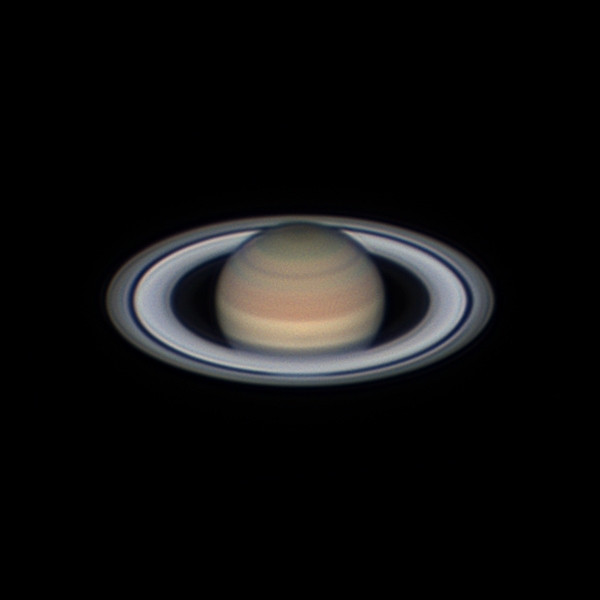
Young Astronomy Photographer of the Year Runner Up: Kimberly Ochoa (USA – aged 14) Snake Moon
The Snake Moon slithers off around the galaxy, eating stars and sliding around on the asteroid belt racing comets, as it has done for thousands of years. Down on Earth, the photographer was moving her camera around facing the Moon and had it in a long exposure, leading her to the Snake Moon. Ulysses, Kansas, USA, 30 March 2017. Canon EOS 700D camera, 250 mm f/14 lens, ISO 100, 16/5-second exposure.
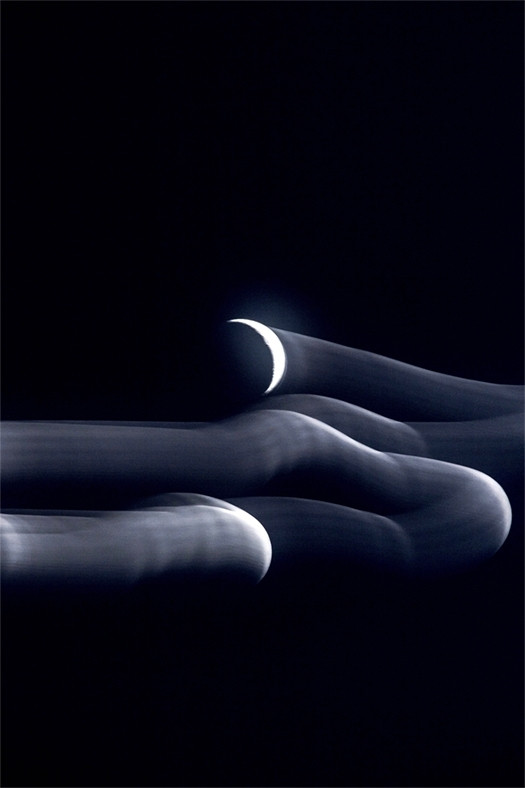
Young Astronomy Photographer of the Year Highly Commended: Fabian Dalpiaz (Italy – aged 15) Milky Way above Alpe di Suisi/Dolomites
The Milky Way stretches across the night sky above the Dolomites in South Tyrol at 5am on a really cold winter morning. Reaching the spot at 4am the photographer waited for the Milky Way to reach its highest position before it got brighter to capture this beautiful scene. This image is a stitch of nine pictures, taken with a 50 mm lens using a normal tripod without a Panohead. Seiser Alm, South Tyrol, Italy, 25 February 2017. Canon EOS 5D Mark III camera, 50 mm f/1.8 lens, ISO 6400, 10-second exposure.

Young Astronomy Photographer of the Year Highly Commended: Sebastien Grech (UK – aged 13) Orion's Gaseous Nebula
Lying 1,300 light years away from Earth, the Orion Nebula is found in Orion's Sword in the famous constellation named after the blade's owner. The Orion Nebula is one of the most photographed and studied objects in the night sky due to the intense activity within the stellar nursery that sees thousands of new stars being created, which also makes it a relatively easy target for beginners. The nebula is thought to measure about 24 light years across and have a mass 2000 times that of our Sun. London, UK, 15 February 2017. Sky-Watcher 150 mm f/5 reflector telescope, Sky-Watcher EQ3 mount, Astronomik CLS filter, Canon EOS 60D camera, ISO 800, 80 x 60-second exposure.

Young Astronomy Photographer of the Year Highly Commended: Andrea Imazio (Italy – aged 8) Rosa Mountain
Taken during a crystal clear winter night as a single long exposure, this image shows the stars glistening above the Rosa Massif Mountain in the Alps. Gressoney, Aosta Valley, Italy, 3 January 2017. Nikon D5500 camera, 18 mm f/3.5 lens, ISO 1600, 20-second exposure.
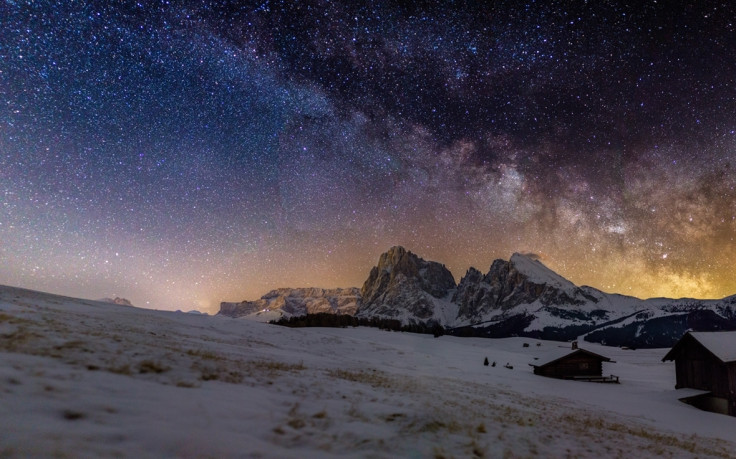
Insight Astronomy Photographer of the Year is run by the Royal Observatory Greenwich in association with Insight Investment and BBC Sky at Night Magazine. Now in its ninth year, the competition received more than 3,800 entries taken from over 90 countries across the globe. The best of these exceptional photographs are showcased in a free exhibition in the Royal Observatory's Astronomy Centre which is open to the public from 17 September 2016 until 28 June 2017. Winners and shortlisted entries will also be published in the competition's official book by Collins, available exclusively in the Royal Observatory Greenwich shop from 17 September and on sale across all bookstores and online from 3 November, £25.
For information about entering next year's competition visit www.rmg.co.uk/astrophoto
© Copyright IBTimes 2025. All rights reserved.






















